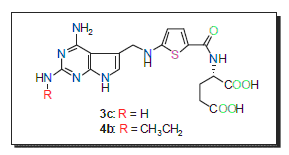| [1] Wang, J.; Xu, Q.-L.; Li, J.-M.; Zhang, E.-L.; Hu, M.-H.; Ye, W.-F.; Huang, W.-J. Chin. J. Org. Chem. 2014, 34, 2040 (in Chinese). (王杰, 许勤龙, 李家明, 张恩立, 胡敏华, 叶文峰, 黄伟军, 有机化学, 2014, 34, 2040.)
[2] Cao, S.-L.; Guo, Y.-W.; Wang, X.-B. Chin. New Drugs J. 2007, 16, 747 (in Chinese). (曹胜利, 郭燕文, 王先波, 中国新药杂志, 16, 747.)
[3] Taylor, E. C.; Patel, H. H. Tetrahedron 1992, 48(37), 8089.
[4] Adjei, A. A. Ann. Oncol. 2000, 11(10), 1335.
[5] Emon, J. H.; Grindey, G. B. Cancer Res. 1978 38(9), 2905.
[6] Norris, R. E.; Adamson, P. C. Cancer Chemother. Pharmacol. 2010, 65(6), 1125.
[7] (a) Mendelsohn, L.-G.; Shih, C.; Schultz, R.-M.; Worzalla, J.-F. Invest. New Drugs 1996 14(3), 287.
(b) Taylor, E.-C.; Wong, G.-S.-K. J. Org. Chem. 1989 54(15), 3618.
[8] (a) Taylor, E. C.; Chaudhari, R.; Lee, K. Invest. New. Drugs 1996, 14(3), 281.
(b) Takimoto, C. H. Oncologist 1996, 1(1~2), 68.
(c) Borrell, J. I.; Teixidó, J.; Martínez-Teipel, B.; Matallana, J. L.; Copete, M. T.; Llimargas, A.; García, E. J. Med. Chem. 1998, 41(18), 3539.
[9] (a) Migawa, M.-T.; Hinkley, J.-M.; Hoops, G.-C. Synth. Commun. 1996, 26(17), 3317.
(b) Klepper, F.; Polborn, K.; Carecell, T. Helv. Chim. Acta 2005, 88(10), 2610.
[10] Gangjee, A.; Mavandadi, F.; Queener, S.-F. J. Med. Chem. 1995, 38(12), 2158.
[11] Gangjee, A.; Mavandadi, F.; Queener, S.-F. J. Med. Chem. 1997, 40(7), 1173.
[12] Alberto, B.; Adamo, F. US 4767758 [Chem. Abstr. 1987, 99, 20162].
[13] (a) Fu, B.; Li, N.; Liang, X.-M.; Dong, Y.-H.; Wang, D.-Q. Chin. J. Org. Chem. 2007, 27(1), 1 (in Chinese). (傅滨, 李楠, 梁晓梅, 董燕红, 王道全, 有机化学, 2007, 27(1), 1.)
(b) Sato, S.; Sakamoto, T.; Miyazawa, E.; Kikugawa, Y. Tetrahedron 2004, 60, 7899.
(c) Jung, Y.-J.; Bae, J.-W.; Park, E.-S.; Chang, Y.-M.; Yoon, C.-M. Tetrahedron 2003, 59, 10331
[14] Taylor, E.-C.; Hamby, J.-M.; Shih, C. J. Med. Chem. 1989, 32(7), 1517.
[15] Yu, X.-H.; Mao, Q.-H.; Zhang, W.-D. J. East China Univ. Sci. Technol., Nat. Sci. Ed. 2005, 31(2), 184 (in Chinese). (虞心红, 毛庆华, 张卫东等, 华东理工大学学报(自然科学版), 2005, 31(2), 184.)
[16] Hodson, S.-J.; Bigham, E.-C.; Duch, D.-S.; Smith, G.-K.; Ferone, R. J. Med. Chem. 1994, 37(13), 2112.
[17] Piper, J.-R.; DeGraw, J.-I.; Colwell, W.-T.; Johnson, C.-A.; Smith, R.-L.; Waud, W.-R.; Sirotnak, F.-M. J. Med. Chem. 1997, 40(3), 377. |
